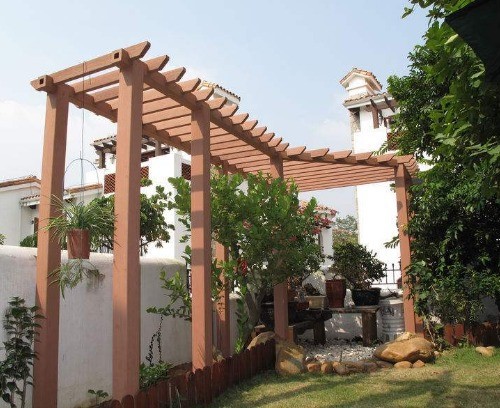Wire drawing is a production process, the purpose of which is to make the product closer to the texture of wood. Wire drawing WPC is mainly used in applications such as pergolas, guardrails, flower boxes, fences, floors, etc.


WPC has the advantages of long service life, beautiful appearance, renewable, low wood cost, insect resistance, anti-corrosion, anti-slip, sprayability, and higher hardness than pure plastic products. It can be processed, bonded and fixed in the same way as wood. Its main features can be summarized as follows: (1) It is durable and has a long lifespan. It has a similar appearance to wood and is harder than plastic. (2) It has excellent physical properties and better dimensional stability than wood. It will not produce cracks, warps, wood knots or diagonal lines. It can be made into a variety of colorful products by adding colorants, coatings or composite surfaces. (3) It has the processability of thermoplastics and is easy to shape. It can be shaped and processed using general plastic processing equipment or after slight modifications. The new investment in processing equipment is small, which is easy to promote and apply. (4) It has similar secondary processability to wood. It can be cut, bonded, connected and fixed with nails or bolts, and painted. The product specifications and shapes can be adjusted according to user requirements, which is very flexible. (5) It is not afraid of insect infestation, aging resistance, corrosion resistance, low water absorption, and will not deform due to moisture absorption. (6) It can be reused and recycled, which is environmentally friendly. (7) It has low maintenance costs.


There are two main ways to manufacture wood-plastic composites: one is to impregnate plastic monomers or low-polymerization resins into solid wood, and to initiate free radical polymerization of plastic monomers or low-polymerization resins in wood by heating or radiation. The resulting composite material is called plastic-plastic composite wood. This composite method can improve the dimensional stability, corrosion resistance, moth resistance, and physical and mechanical properties of wood. The impregnated monomers generally use monomers such as styrene and methyl methacrylate. The other is to add wood in the form of wood shavings, fibers and wood powder as a reinforcing material or filler to thermoplastic plastics, and to compound the wood with the molten thermoplastic plastics by heating to obtain a composite material, which is called wood-plastic composite material (abbreviated as WPC).


As a new type of material between wood and plastic, wood-plastic composite materials have a series of special properties that are superior to wood and plastic: they have the appearance and secondary processing properties of wood, low water absorption, insect resistance, and will not crack or warp like wood; they can be processed like thermoplastic materials, but have higher hardness, wear resistance, aging resistance and corrosion resistance than plastics; adding various additives can give them more special properties, such as no bacteria, good flame retardancy, strong acid and alkali resistance, etc.; adding colorants, films or composite surface layers can produce various products with charming colors and patterns. In particular, recycled waste plastics and waste wood can not only be used as processing raw materials for wood-plastic composite materials, but the composite materials themselves can also be recycled and reused, which is of great significance to reducing environmental pollution and protecting forest resources.
Hot Tags: brushed wpc, China brushed wpc manufacturers, suppliers, Corridor WPC Ceiling Panel, Outdoor Privacy WPC Fence, Parquet Wood Outdoor Flooring, Parquet WPC Floor, New Design WPC Ceiling Panel, Outdoor Engineered WPC Decking








